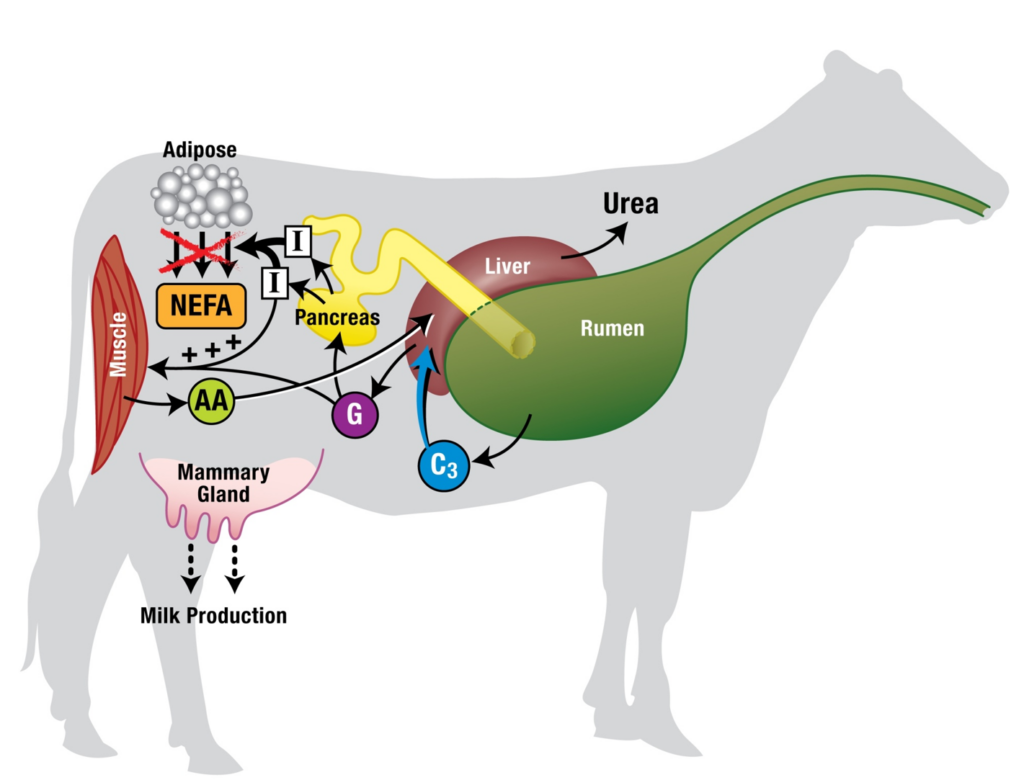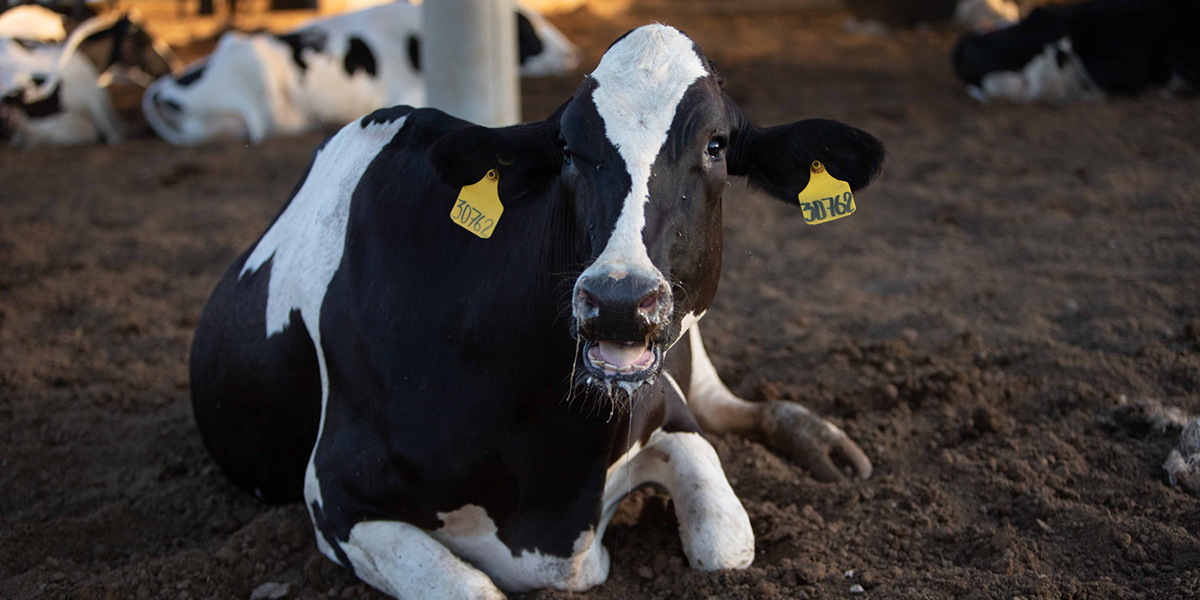Heat stress, as defined by a Temperature Humidity Index (THI) > 72, is a challenge most dairy producers expect every year. As cows try to maintain body temperature and stay cool, dry matter intake and milk output often suffer. The impact of heat stress is cumulative, meaning cows may bounce back from one event but over time, repeated bouts take longer recovery and hinder performance and profitability. Nutrition is a valuable tool to help mitigate the effects of heat stress to maintain herd productivity.
Heat stress is a threat to rumen health – which is why it often depresses herd productivity. As the cow struggles to dispel heat, blood flow is diverted away from the digestive tract and internal organs to the skin, for more effective heat dissipation. Not only does this impact nutrient absorption, it diverts nutrients away from key functions such as reproduction and lactation, which can increase days open and lower milk output. With energy being redirected from those key functions, health and body condition can be harder to maintain.
Typical Responses to Heat Stress
- Decreased feed intake
- Decreased milk production
- Increased muscle breakdown to meet higher glucose demands
- Loss of body condition
- Increased rumen acidosis
- Leaky gut and inflammation
- Poor reproductive performance

Cows experiencing heat stress (THI > 72) are not able to mobilize adipose tissue to meet increased energy needs like non heat-stressed cows. Instead, the heat-stressed cow catabolizes, or breaks down, muscle to meet increased glucose demands. The resulting reduction in body condition is actually the loss of muscle mass, not a loss of fat stores as is typically the case when cows experience stress or are in negative energy balance.
Rumen First Nutrition for Combatting Heat Stress
Tailoring your nutritional strategy to benefit the rumen microbiome equips cows to better meet energy and protein needs to keep performing through hotter temperatures. Increasing nutrient concentration in the ration may help offset decreased dry matter intake yet create more heat from digestion and increase the risk of rumen acidosis. Alternatively, you can focus on feeding the rumen microbes directly with branched-chain volatile fatty acids (BCVFAs), also known as isoacids. When the focus is on feeding rumen microbes first, by supplying essential nutrients in the form of BCVFAs, less rumen degradable protein is required, and feedstuff digestibility is improved. These benefits enable the cow to improve energy-corrected milk with greater feed efficiency. With this nutritional strategy, you can ensure cows maintain productivity and require less inputs, protecting your profitability.
Zinpro® IsoFerm® is a unique blend of branched-chain VFAs proven to significantly enhance rumen function by directly feeding the rumen microbiome and specifically the fiber-digesting microbes. Multiple studies have shown the positive benefits of supplementing lactating dairy cattle diets with BCVFAs. By enhancing rumen performance, Zinpro IsoFerm can help reduce the negative effects of heat stress and protect summer productivity.
Three Ways Zinpro IsoFerm Supports Cows During Heat Stress
By more efficiently supplying the branched-chain volatile fatty acids that the cow is naturally trying to produce in the rumen, Zinpro IsoFerm increases microbial growth and fiber digestibility resulting in greater metabolizable protein and blood glucose levels. These benefits work to offset the negative effects of heat stress explained earlier and help cows to maintain milk and component production during summer months.
As mentioned earlier, one of the responses in heat-stressed cows is the breakdown of muscle to be utilized as energy. Zinpro IsoFerm increases microbial protein produced in the rumen, which increases the supply of metabolizable protein thus reducing the need to mobilize muscle while more effectively meeting energy demands. Since the cow doesn’t need to catabolize muscle, body condition is preserved and she is better positioned to perform during and following hotter temperatures. The benefits of BCVFAs on maintaining muscle mass and body condition were demonstrated in a study conducted at Purdue University and observed in multiple field demonstrations.
Zinpro IsoFerm also increases blood glucose levels. This provides a readily available energy source for milk production and reproduction while helping meet the increased glucose demand by the immune system. These findings were also witnessed in the Purdue University study.
Lastly, the BCVFAs contained in Zinpro IsoFerm have consistently shown, both in controlled research and on-farm application, to increase microbial growth and fiber digestibility. When rumen bacteria are supplemented with the specific BCVFAs they require, they are able to more efficiently break down dietary fiber, which lowers the heat of fermentation in the rumen. When the heat of fermentation is lowered, the overall heat stress of the cow is reduced, allowing her to achieve a higher level of performance than is normally expected during elevated temperatures.
Supplementation Should Begin Before Hot Weather Arrives
Feeding Zinpro IsoFerm before heat stress arrives prepares cows to better respond to rising temperatures. By providing rumen bacteria with essential nutrients for microbial growth, cows can improve energy production and utilization, preventing typical losses in DMI, milk volume and components. You can learn more about the mode of action by watching this video.
It is well understood that the rumen itself is an ecosystem and must be cared for and managed well to maximize dairy cow performance. Because the rumen microbiome is a mix of sugar, starch and fiber digesting bacteria, it is necessary to begin incorporating Zinpro IsoFerm into diets several weeks before the onset of heat stress in order for the rumen to properly adapt. Ideally, cows should begin to receive Zinpro IsoFerm during the transition period, where fiber-digestion benefits have been shown to improve fresh cow performance and set up animals for a more successful lactation. By feeding Zinpro IsoFerm in transition and continuing throughout lactation, the entire herd will be primed to navigate hot weather and protect summer productivity and profitability.
Protect Summer Productivity with Zinpro IsoFerm
Do you want to reduce the impact of heat stress on dairy cow performance and profitability? Ask your Zinpro® representative if Zinpro IsoFerm is a fit in your dairy diets and can be an integral part of maintaining greater performance, efficiency and profitability during periods of heat stress. To learn more about the benefits of Zinpro IsoFerm, visit www.zinpro.com/isoferm.

